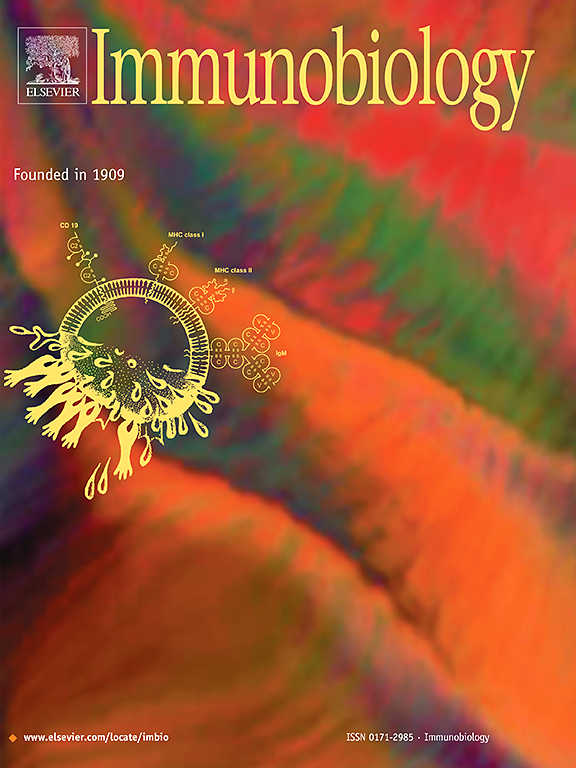NOD-like receptor family pyrin domain containing 3 (rs10754558) gene polymorphism in chronic spontaneous urticaria: A pilot case-control study
IF 2.3
4区 医学
Q3 IMMUNOLOGY
引用次数: 0
Abstract
Background
Chronic spontaneous urticaria (CSU) is a persistent skin condition with no known cause or trigger. The unpredictability of CSU attacks lowers patients' quality of life. NOD-like receptor pyrin domain containing 3 (NLRP3) gene dysregulation can result in numerous immunological and inflammatory diseases.
Objective
This case-control study aimed to determine the association between the NLRP3 inflammasome (rs10754558) single nucleotide polymorphism (SNP) and the occurrence, severity and etiology of CSU.
Methods
Each study group included 62 participants; all were subjected to CSU severity evaluation by the urticaria activity score (UAS), autologous serum skin testing (ASST) and NLRP3 (rs10754558) genotyping.
Results
The NLRP3 (rs10754558) CG genotype was the most predominant in both study groups, followed by the CC genotype (41.9 %) in the CSU group and the GG genotype (25.8 %) in the control group. Most of the CSU group (66.1 %) had the C allele, compared to most controls (53.2 %) with the G allele. The frequency of NLRP3 (rs10754558) genotypes and alleles did not differ significantly according to the severity of CSU by UAS (P > 0.05). The prevalence of the CC genotype was significantly higher among the ASST-positive CSU patients. The C allele elevated the likelihood of positive ASST in CSU patients by 21 times, suggesting the autoimmune theory of CSU. None of the ASST-positive patients had the GG genotype.
Conclusion
The NLRP3 inflammasome (rs10754558) C allele may be associated with CSU risk but not severity by UAS. It may also be associated with ASST positivity which suggests a connection between the C-allele and the autoimmune notion of CSU.
nod样受体家族pyrin结构域包含3 (rs10754558)基因多态性在慢性自发性荨麻疹中:一项试点病例对照研究
背景:慢性自发性荨麻疹(CSU)是一种没有已知病因或诱因的持续性皮肤疾病。CSU发作的不可预测性降低了患者的生活质量。nod样受体pyrin结构域包含3 (NLRP3)基因的失调可导致多种免疫和炎症性疾病。目的:本病例对照研究旨在确定NLRP3炎性小体(rs10754558)单核苷酸多态性(SNP)与CSU发生、严重程度及病因的关系。方法:每个研究组62例;通过荨麻疹活动性评分(UAS)、自体血清皮肤试验(自体血清皮肤试验)和NLRP3 (rs10754558)基因分型对所有患者进行CSU严重程度评估。结果:两组患者均以NLRP3 (rs10754558) CG基因型居多,CSU组其次为CC基因型(41.9%),对照组为GG基因型(25.8%)。大多数CSU组(66.1%)具有C等位基因,而大多数对照组(53.2%)具有G等位基因。NLRP3 (rs10754558)基因型和等位基因频率在不同UAS CSU严重程度间无显著差异(P < 0.05)。在asst阳性的CSU患者中,CC基因型的患病率明显更高。在CSU患者中,C等位基因升高了21倍的可能性,提示CSU的自身免疫理论。asst阳性患者均无GG基因型。结论:NLRP3炎性小体(rs10754558) C等位基因可能与CSU风险相关,但与UAS的严重程度无关。它也可能与自体皮肤抗原阳性有关,这表明c等位基因与CSU的自身免疫概念之间存在联系。
本文章由计算机程序翻译,如有差异,请以英文原文为准。
求助全文
约1分钟内获得全文
求助全文
来源期刊

Immunobiology
医学-免疫学
CiteScore
5.00
自引率
3.60%
发文量
108
审稿时长
55 days
期刊介绍:
Immunobiology is a peer-reviewed journal that publishes highly innovative research approaches for a wide range of immunological subjects, including
• Innate Immunity,
• Adaptive Immunity,
• Complement Biology,
• Macrophage and Dendritic Cell Biology,
• Parasite Immunology,
• Tumour Immunology,
• Clinical Immunology,
• Immunogenetics,
• Immunotherapy and
• Immunopathology of infectious, allergic and autoimmune disease.
 求助内容:
求助内容: 应助结果提醒方式:
应助结果提醒方式:


